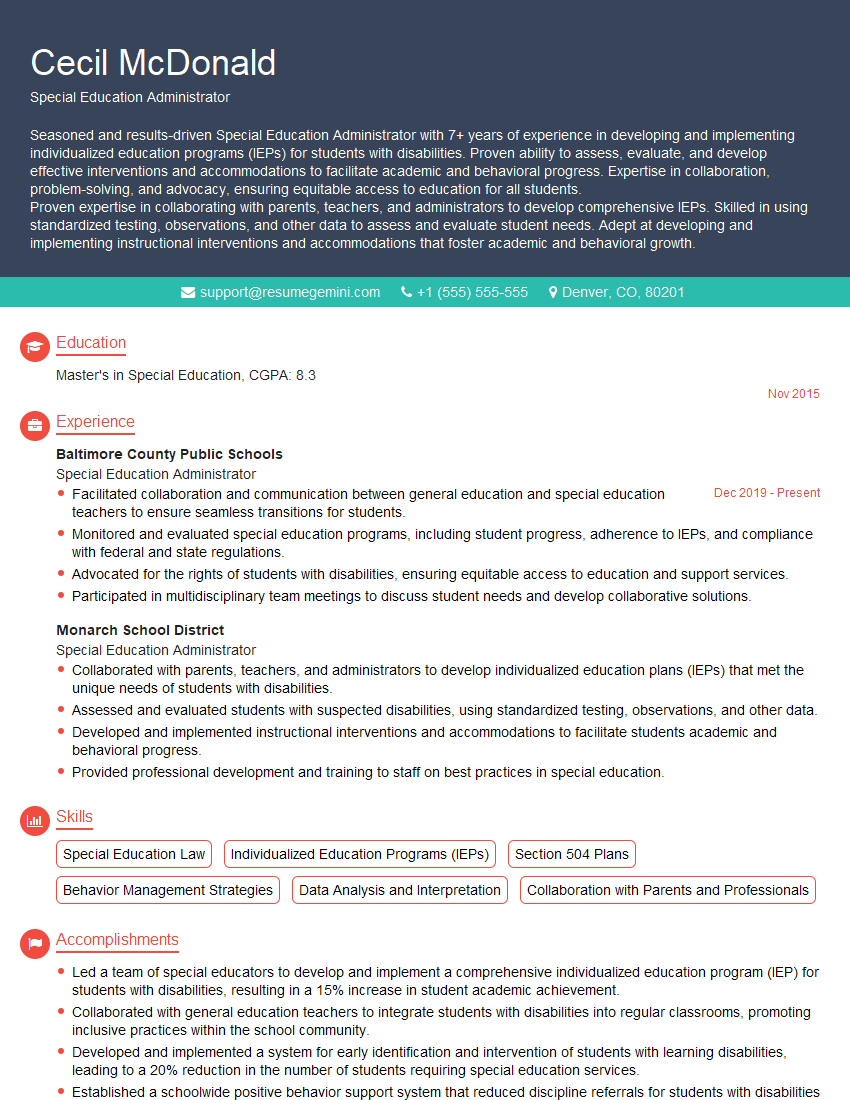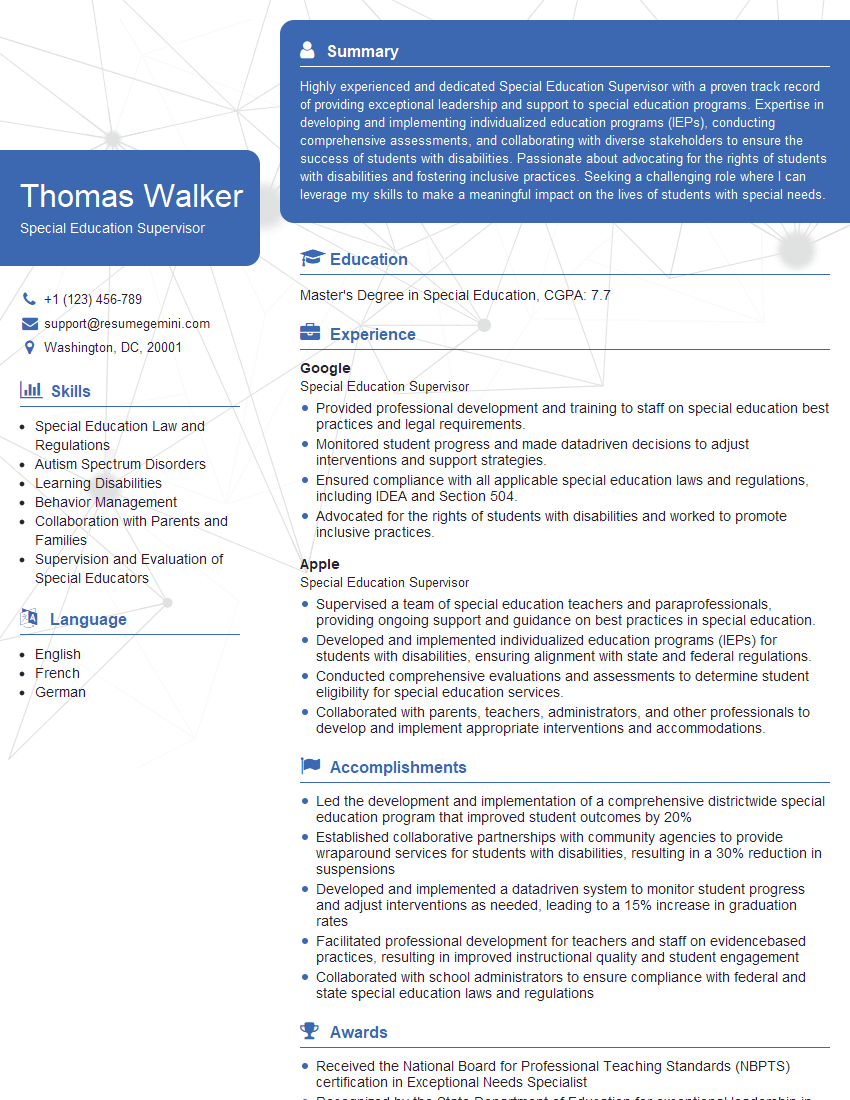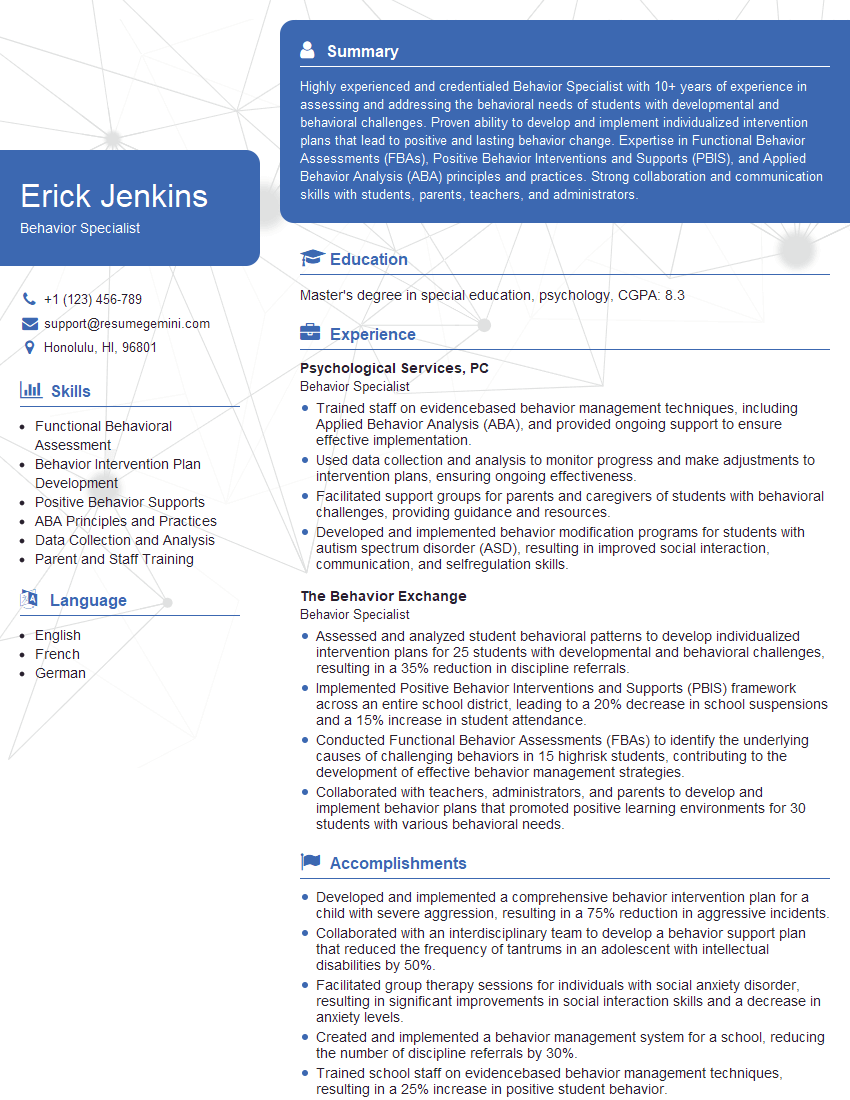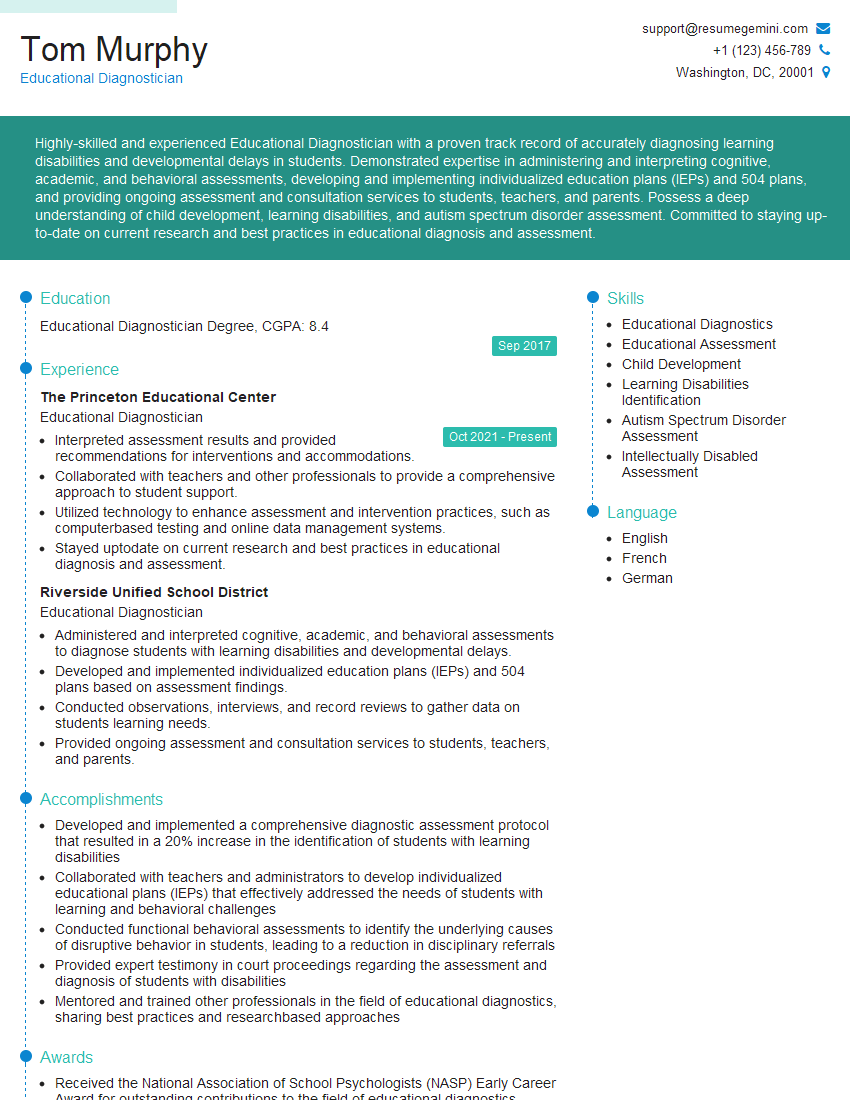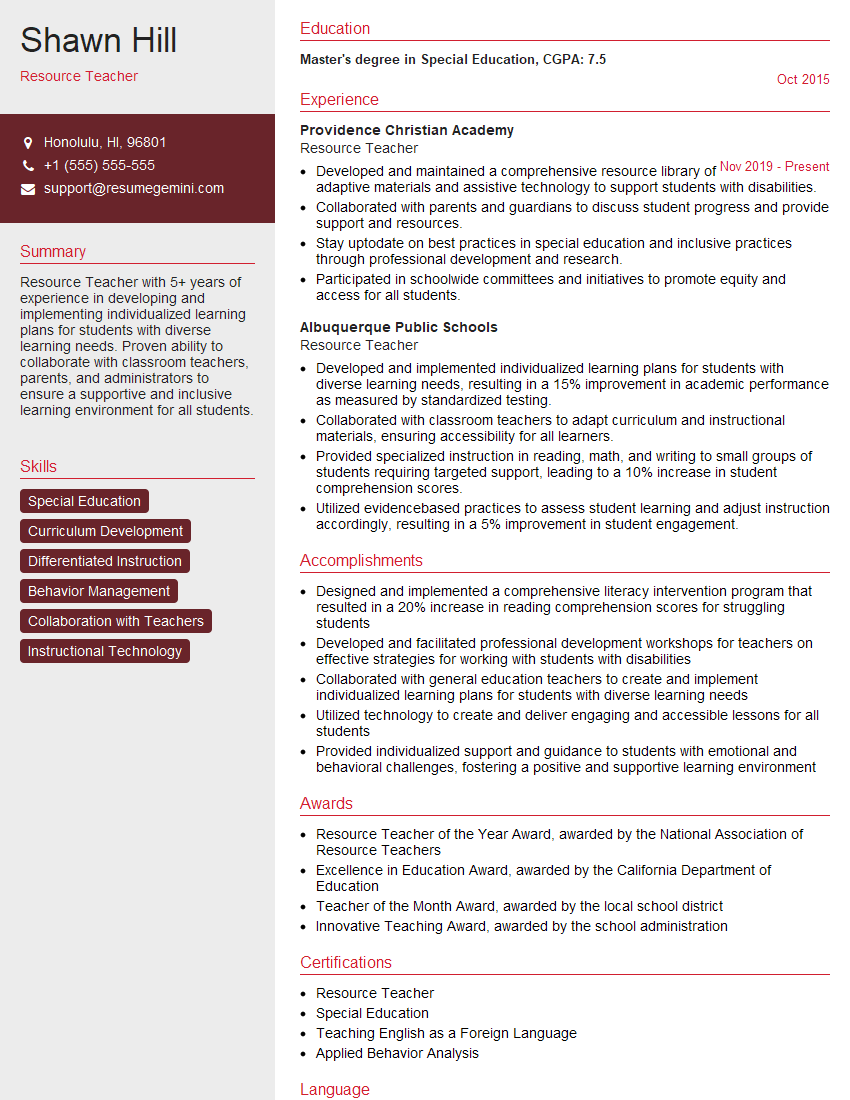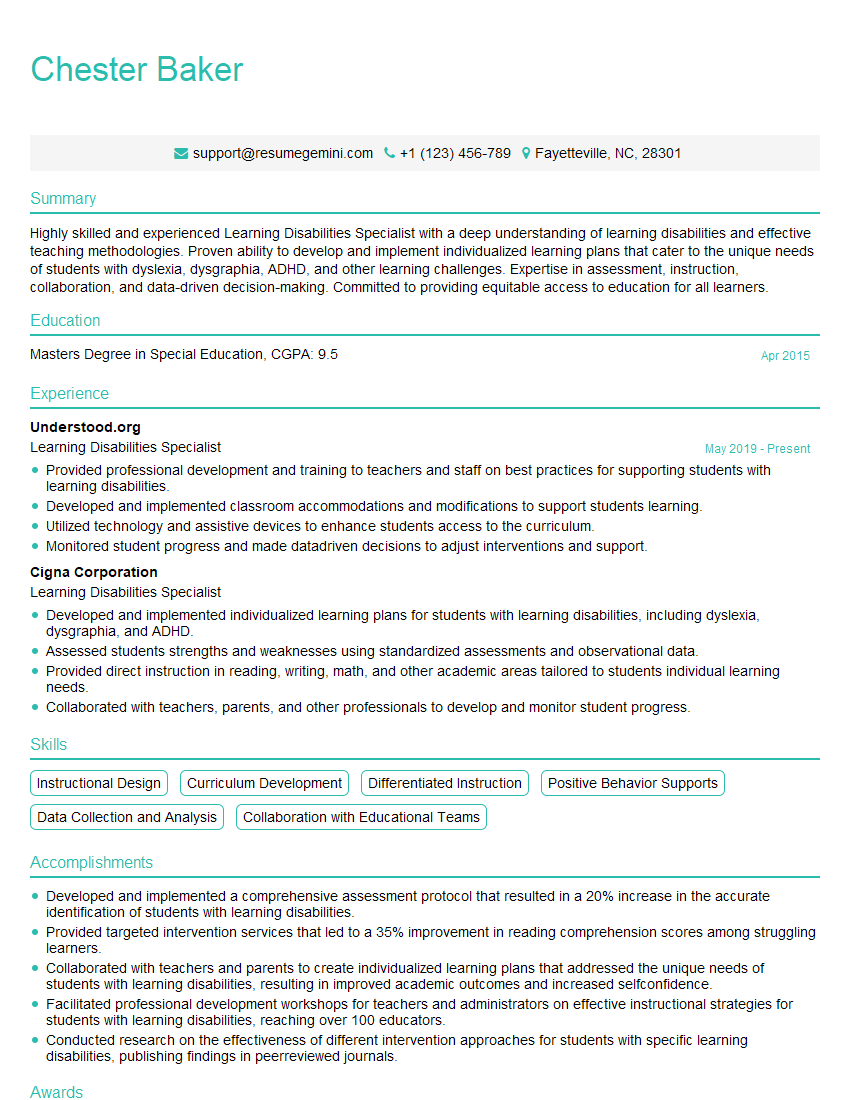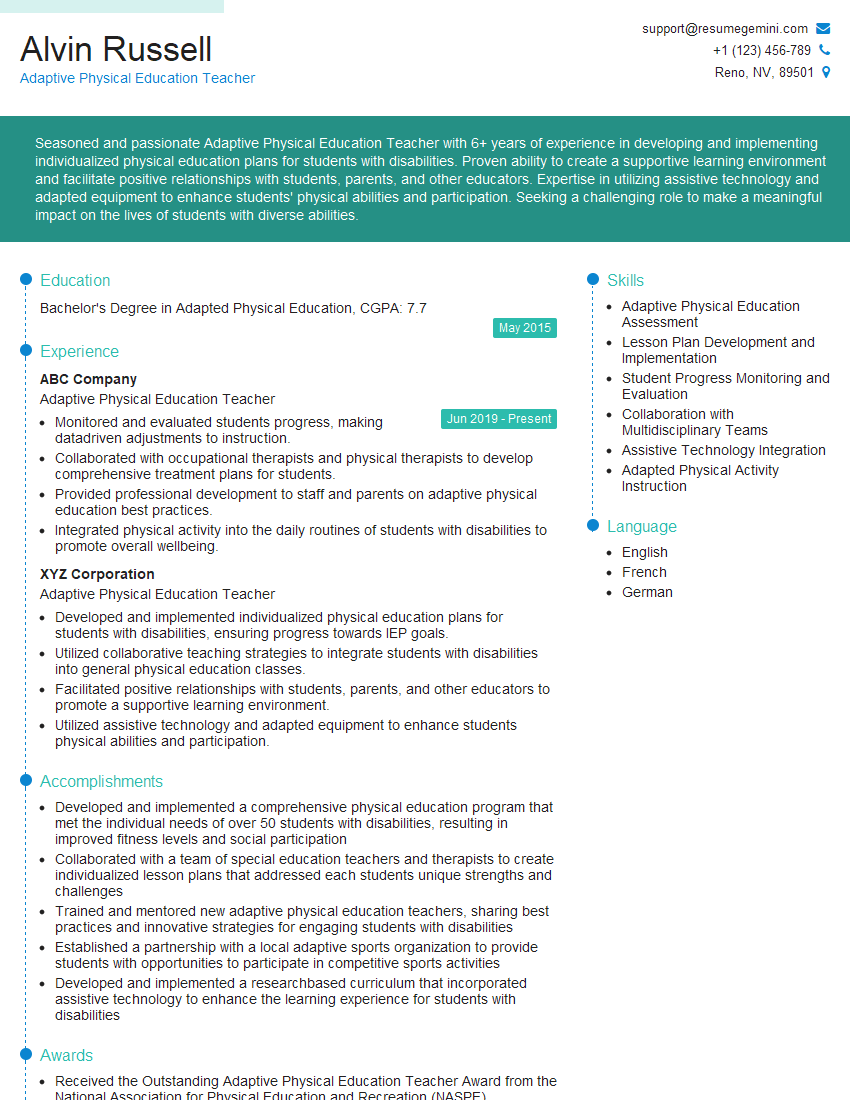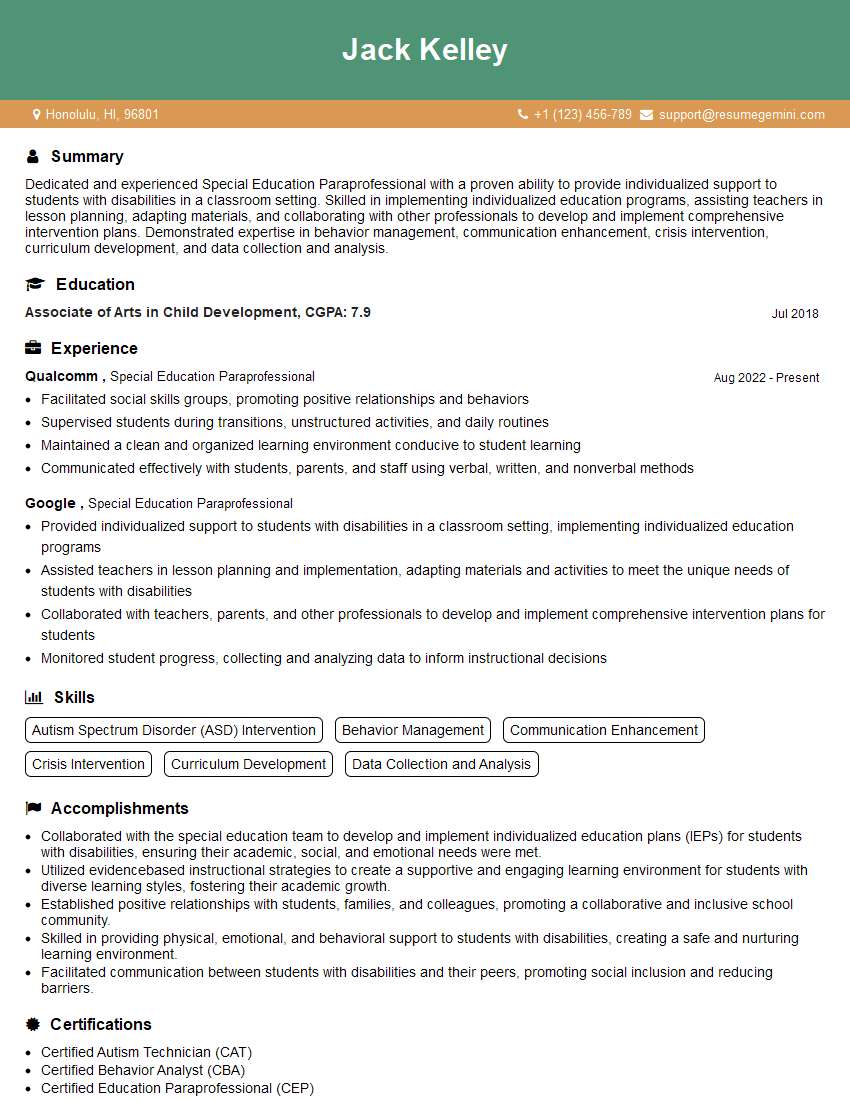The thought of an interview can be nerve-wracking, but the right preparation can make all the difference. Explore this comprehensive guide to Individualized Education Program (IEP) Development and Implementation interview questions and gain the confidence you need to showcase your abilities and secure the role.
Questions Asked in Individualized Education Program (IEP) Development and Implementation Interview
Q 1. Describe the process of developing an IEP from initial referral to implementation.
The IEP development process begins with a referral, often initiated by a teacher, parent, or other concerned party who observes significant learning difficulties or disabilities. This referral triggers an evaluation process where a multidisciplinary team assesses the student’s academic, social-emotional, and behavioral functioning. This assessment may include standardized tests, teacher observations, parent input, and other relevant data.
Once the evaluation is complete, a meeting is held to determine if the student is eligible for special education services. If eligibility is determined, the IEP team—comprising parents, educators, specialists (e.g., school psychologist, special education teacher), and the student (when appropriate)—collaborates to develop the IEP. This plan outlines the student’s current levels of performance, measurable goals, specific services and supports needed, and how progress will be monitored. The IEP is then implemented, with regular progress monitoring and meetings to review and revise as needed. Think of it like building a house: the referral is laying the foundation, the evaluation is the blueprint, the IEP meeting is the construction, and implementation is moving in.
- Referral: Identifying a need for support.
- Evaluation: Assessing the student’s strengths and weaknesses.
- Eligibility Determination: Deciding if special education is warranted.
- IEP Meeting: Collaborating to create the plan.
- Implementation: Putting the IEP into action.
- Monitoring and Review: Tracking progress and making adjustments.
Q 2. Explain the role of parents/guardians in the IEP process.
Parents/guardians are integral to the IEP process. They are considered equal partners and have the right to participate in all phases, from the initial referral to the ongoing monitoring and review. Their knowledge of their child’s strengths, needs, and learning styles is invaluable. They are key decision-makers in determining appropriate goals and services. Imagine designing a personalized fitness plan – the trainer (the IEP team) needs the client (the parent) to describe their lifestyle, preferences, and fitness goals to create something effective. Parents also have the right to refuse services and to request due process if they disagree with IEP recommendations.
- Active Participation: Attending all meetings and providing valuable input.
- Informed Consent: Agreeing to the plan before implementation.
- Advocacy: Protecting their child’s rights and interests.
- Collaboration: Working closely with educators to ensure success.
Q 3. What are the key components of a legally sound IEP?
A legally sound IEP must include several key components to ensure compliance with federal and state laws (e.g., IDEA). These elements are essential for providing a free and appropriate public education (FAPE) to students with disabilities. Missing even one could lead to legal challenges.
- Present Levels of Performance (PLP): A description of the student’s current academic, social, and behavioral skills and needs.
- Measurable Annual Goals (MAGs): Specific, measurable, achievable, relevant, and time-bound (SMART) goals that outline what the student will achieve within one year.
- Special Education and Related Services: Specific services the student will receive to help them meet their goals (e.g., speech therapy, occupational therapy, counseling).
- Participation in General Education: A description of how the student will be included in the general education curriculum.
- Evaluation Procedures: How the student’s progress towards goals will be monitored and how the IEP will be reviewed (at least annually).
- Dates and Locations: Specific information about when and where services will be provided.
- Transition Services: For students aged 16 and older, plans for transitioning to post-secondary education, employment, or independent living.
Q 4. How do you ensure that an IEP is individualized to the student’s unique needs?
Individualizing an IEP requires a deep understanding of the student’s unique strengths, weaknesses, and learning preferences. This starts with comprehensive assessment data that goes beyond standardized tests. We need to consider the student’s cultural background, learning styles, interests, and preferred communication methods. The IEP team collaborates to determine the most effective instructional strategies, accommodations, and modifications to address the student’s individual needs. For example, a student with dyslexia might benefit from assistive technology, while a student with ADHD may need frequent breaks and a structured learning environment.
- Strengths-Based Approach: Building upon the student’s existing skills.
- Differentiated Instruction: Adapting teaching methods to meet diverse learning styles.
- Assistive Technology: Providing tools to support learning.
- Accommodations and Modifications: Adjusting the learning environment or curriculum as needed.
- Collaboration and Communication: Regular communication among team members and parents.
Q 5. How do you differentiate instruction to meet the diverse learning styles of students with IEPs?
Differentiating instruction is crucial for students with IEPs. It means adapting teaching methods, materials, and assessments to meet the varied learning styles and needs within a classroom. This might involve using a variety of instructional strategies, such as visual aids, hands-on activities, and collaborative learning. For example, a student who learns best through kinesthetic activities might benefit from building models or participating in role-playing exercises. A student who excels with visual learning might thrive with graphic organizers and mind maps. The key is understanding each student’s learning preferences and adapting to them.
- Varied Instructional Strategies: Using different approaches like lectures, discussions, group work, and independent practice.
- Multiple Representations of Information: Presenting information in diverse formats like text, audio, and visuals.
- Flexible Grouping: Using different group structures (individual, small group, whole class) depending on the task.
- Accommodations and Modifications: Making changes to assignments or assessments to remove barriers to learning.
- Universal Design for Learning (UDL): Applying principles of flexibility, multiple means of representation, action, and engagement.
Q 6. What are the different types of assessment data used in IEP development?
IEP development relies on a variety of assessment data to provide a comprehensive picture of a student’s abilities and needs. This isn’t just about test scores; it’s about understanding the whole child.
- Standardized Tests: Norm-referenced tests comparing a student’s performance to a larger group.
- Curriculum-Based Assessments (CBAs): Measuring performance on specific curriculum content.
- Observations: Directly observing student behavior and learning in different settings.
- Informal Assessments: Using various methods like projects, portfolios, and classwork to gauge understanding.
- Teacher-made Assessments: Created by teachers to evaluate specific skills.
- Parent and Student Input: Valuable insights from the family’s perspective and the student’s self-perception.
Q 7. How do you collaborate effectively with the IEP team?
Effective collaboration is paramount in IEP development and implementation. It involves clear communication, mutual respect, and a shared understanding of the student’s needs. The team needs to work together as a cohesive unit, not as individual silos. Think of it like a sports team – each player has a unique skill set but success comes from everyone playing their part and supporting one another.
- Active Listening: Paying close attention to all team members’ perspectives.
- Open Communication: Sharing information transparently and frequently.
- Shared Decision-Making: Collaboratively determining goals and services.
- Respectful Dialogue: Creating a safe space for expressing ideas and concerns.
- Regular Meetings: Meeting regularly to monitor progress and make adjustments.
- Documenting Decisions: Keeping detailed records of IEP meetings and decisions made.
Q 8. Explain the concept of Least Restrictive Environment (LRE) and its application in IEP development.
The Least Restrictive Environment (LRE) is a cornerstone of the Individuals with Disabilities Education Act (IDEA). It mandates that students with disabilities be educated alongside their non-disabled peers to the maximum extent appropriate. This doesn’t mean placing a student in a general education classroom regardless of their needs; instead, it emphasizes finding the educational setting that provides the necessary support while minimizing the restrictions on their learning.
In IEP development, determining the LRE involves a careful consideration of the student’s unique needs and the supports available in various settings. This often includes a continuum of placements, ranging from general education classrooms with support services (like a resource teacher or paraprofessional) to separate special education classrooms. The decision is individualized and documented in the IEP, justifying the chosen placement based on the student’s progress and needs. For instance, a student with mild learning difficulties might thrive in a general education class with supplementary instruction, while a student with more severe needs might require a more specialized setting. The IEP team collaboratively determines the most appropriate placement, ensuring it is the least restrictive setting that can effectively meet the student’s educational needs.
Q 9. How do you measure the effectiveness of an IEP?
Measuring IEP effectiveness is crucial for ensuring the student is making progress toward their goals. It’s not a single metric but a multifaceted process involving data collection from various sources. We assess progress using multiple methods:
- Progress Monitoring: Regular assessments (e.g., quizzes, tests, projects, observations) track the student’s performance against their IEP goals. This provides ongoing feedback and allows for timely adjustments if needed. For example, if a student’s reading fluency isn’t improving as expected, we might adjust their reading intervention strategies.
- Data Analysis: Analyzing data collected through progress monitoring helps determine the efficacy of interventions. Trends in student performance highlight what’s working well and what needs to be changed.
- Teacher and Parent Input: Qualitative data from teachers, parents, and the student themselves provide valuable insights into their progress and challenges. This subjective information complements the objective data from assessments.
- Functional Behavior Assessment (FBA) data (if applicable): If behavioral goals are part of the IEP, FBA data tracks the effectiveness of behavioral interventions.
The IEP team regularly reviews the data and collaboratively makes decisions about adjustments to the IEP to ensure its effectiveness. It’s important to remember that IEP effectiveness isn’t just about academic progress; it’s also about social-emotional growth and overall well-being.
Q 10. Describe your experience writing measurable goals and objectives for IEPs.
Writing measurable IEP goals and objectives is essential for tracking student progress and ensuring accountability. I use the SMART criteria (Specific, Measurable, Achievable, Relevant, Time-bound) to create effective goals. For example, instead of a goal like “Improve reading comprehension,” a measurable goal would be: “Given a grade-level passage, the student will answer 80% of comprehension questions correctly in 8 out of 10 trials by June 1st.”
Here’s how I approach this process:
- Collaboratively Define Areas of Need: I work closely with the IEP team (teachers, parents, specialists, and the student when appropriate) to identify the student’s specific learning challenges and strengths.
- Develop SMART Goals: For each identified area of need, we create SMART goals that are specific, measurable, achievable, relevant, and time-bound. This ensures that we can track the student’s progress effectively.
- Break Down Goals into Objectives: We often break down larger goals into smaller, more manageable objectives. This allows for more frequent monitoring and adjustment. For example, the larger goal mentioned above might have objectives around vocabulary development, reading strategy instruction, and independent reading practice.
- Regularly Review and Adjust: The IEP is not a static document. We continuously monitor the student’s progress and make necessary adjustments to goals and objectives as needed.
This approach ensures that the IEP is aligned with the student’s needs and allows us to objectively measure their progress and make data-driven decisions about interventions and supports.
Q 11. How do you address behavioral challenges in the classroom for students with IEPs?
Addressing behavioral challenges for students with IEPs requires a multi-pronged approach rooted in understanding the underlying causes of the behavior. I start with a Functional Behavior Assessment (FBA), which is a systematic process for identifying the function of a student’s challenging behavior. The FBA helps us understand why the student is engaging in the behavior (e.g., to escape a task, gain attention, or meet sensory needs).
Based on the FBA, we develop a Behavior Intervention Plan (BIP), which outlines strategies to address the behavior. This might include positive behavior supports (PBS), such as teaching replacement behaviors, providing positive reinforcement, and modifying the environment to reduce triggers. For instance, if a student is disrupting class to gain attention, the BIP might focus on teaching them alternative ways to seek attention, such as raising their hand or approaching the teacher. Regular monitoring and data collection are crucial to ensure the BIP is effective. Collaboration with parents, teachers, and other specialists is vital for successful implementation and adjustment. We always prioritize the student’s safety and well-being while ensuring that the strategies used are positive and effective.
Q 12. What strategies do you use to involve parents/guardians in the student’s IEP implementation?
Parent/guardian involvement is crucial for successful IEP implementation. I prioritize open communication and collaboration at every stage, from the initial assessment to ongoing monitoring. Here are some key strategies I employ:
- Regular Communication: I maintain frequent contact with parents/guardians through various methods (e.g., phone calls, emails, meetings) to discuss the student’s progress, address concerns, and plan for the future.
- Active Participation in IEP Meetings: I ensure that parents/guardians actively participate in the development and review of the IEP. I provide them with clear and concise information about the process and their role.
- Shared Decision-Making: I encourage parents/guardians to share their insights and perspectives, and collaborate with them to develop strategies that work best for their child.
- Providing Resources and Support: I provide parents/guardians with relevant resources and information to support their child’s learning at home. I might also connect them with community resources.
- Home-School Collaboration: I work closely with parents/guardians to develop strategies that can be consistently implemented at both school and home. Consistent expectations and approaches create a supportive learning environment for the student.
By fostering a strong partnership with parents/guardians, we create a supportive and collaborative environment that promotes the student’s success.
Q 13. How familiar are you with IDEA (Individuals with Disabilities Education Act)?
I am very familiar with the Individuals with Disabilities Education Act (IDEA). I understand its key components, including the six principles of IDEA: zero reject, nondiscriminatory evaluation, individualized education program (IEP), least restrictive environment (LRE), due process, and parental participation. I am adept at navigating the legal requirements of IDEA and ensuring that IEPs are developed and implemented in compliance with all applicable laws and regulations. This includes understanding the procedures for conducting evaluations, holding IEP meetings, and resolving disputes. I stay updated on any changes or amendments to IDEA and their implications for IEP development and implementation.
Q 14. Describe your experience with different types of accommodations and modifications for students with IEPs.
My experience encompasses a wide range of accommodations and modifications for students with IEPs. Accommodations do not alter the content of the curriculum, but they change how the student accesses it. Modifications, on the other hand, actually change the content or expectations of the curriculum. Examples include:
- Accommodations: Extra time on tests, preferential seating, use of assistive technology (e.g., text-to-speech software, graphic organizers), adjusted presentation formats (e.g., large print, audio recordings), frequent breaks, alternative assessment methods (e.g., oral responses instead of written responses).
- Modifications: Modified assignments (e.g., fewer problems on a worksheet, simplified instructions), alternative curriculum materials (e.g., using a lower reading level text), adjusted grading criteria, reduced homework assignments, different learning goals.
I tailor the selection of accommodations and modifications based on the student’s individual needs and the specific learning demands of the task or assignment. The ultimate goal is to ensure that the student has equitable access to the curriculum and can demonstrate their learning in the most effective way possible. For instance, a student with ADHD might benefit from accommodations like preferential seating and frequent breaks to minimize distractions, while a student with dyslexia might need modifications like audio recordings of texts and extended time on tests.
Q 15. How do you adapt curriculum to meet the needs of students with IEPs?
Adapting the curriculum for students with IEPs involves creating individualized learning experiences that align with their unique strengths and needs. It’s not about lowering standards but modifying the how of learning.
- Differentiation: This is key. We adjust the content (what is learned), the process (how it’s learned), and the product (how learning is demonstrated). For example, a student struggling with reading comprehension might receive audio-enhanced texts, shorter reading assignments with focused comprehension questions, and the opportunity to demonstrate understanding through oral presentations instead of written essays.
- Universal Design for Learning (UDL): UDL provides a framework for creating flexible learning environments. This means offering multiple means of representation (e.g., visual aids, graphic organizers), action and expression (e.g., hands-on activities, technology-based projects), and engagement (e.g., choice in assignments, collaborative learning).
- Assistive Technology Integration: Technology plays a crucial role. This could include text-to-speech software, speech-to-text software, or graphic organizers for note-taking. The specific technology is carefully selected based on the student’s individual needs.
- Collaboration: Close collaboration with the special education teacher, general education teacher, and other related service providers is vital to ensure a cohesive and effective approach.
For instance, I worked with a student with dysgraphia (difficulty with writing). We implemented assistive technology like a voice-to-text program, allowing him to focus on his ideas rather than the mechanics of writing. We also adjusted assignments, allowing him to use alternative methods like oral presentations or digital recordings to demonstrate his understanding.
Career Expert Tips:
- Ace those interviews! Prepare effectively by reviewing the Top 50 Most Common Interview Questions on ResumeGemini.
- Navigate your job search with confidence! Explore a wide range of Career Tips on ResumeGemini. Learn about common challenges and recommendations to overcome them.
- Craft the perfect resume! Master the Art of Resume Writing with ResumeGemini’s guide. Showcase your unique qualifications and achievements effectively.
- Don’t miss out on holiday savings! Build your dream resume with ResumeGemini’s ATS optimized templates.
Q 16. Describe your experience with assistive technology and its role in IEP implementation.
Assistive technology (AT) is an integral part of successful IEP implementation. It provides tools and strategies that compensate for a student’s disability and enhances their ability to learn and participate. My experience spans various AT solutions, from low-tech options like adapted pencil grips to high-tech solutions like screen readers and augmentative and alternative communication (AAC) devices.
- Needs Assessment: I begin by conducting a thorough assessment of the student’s needs to determine the most appropriate AT. This involves observing the student in the classroom, reviewing their IEP, and collaborating with the occupational therapist and other professionals.
- Trial and Training: We don’t just hand the student technology; we provide training and support to ensure they understand how to use it effectively. We might trial different devices before choosing one that best fits the student’s learning style and needs. For instance, I’ve found that some students respond well to one type of speech-to-text software while others prefer a different one.
- Integration into Curriculum: The AT is integrated into the curriculum seamlessly. It’s not a separate activity but a tool to enhance the learning process.
- Ongoing Evaluation: We continuously monitor the effectiveness of the AT and make adjustments as needed. The technology must remain a supportive tool; if it’s not aiding the student, we need to re-evaluate.
For example, I worked with a student with visual impairments who benefited greatly from a screen reader and other specialized software that enlarged text and provided audio descriptions. The successful implementation involved careful training, ongoing support, and curriculum adjustments to accommodate the technological aids.
Q 17. How do you facilitate the transition process for students with IEPs to post-secondary education or employment?
Transition planning for students with IEPs is a crucial aspect that begins well in advance of their exit from high school. The focus is on preparing them for successful post-secondary education or employment, depending on their individual goals and aspirations. This is an ongoing process that involves collaboration with the student, their family, school staff, and community agencies.
- Individualized Transition Plan (ITP): The ITP, a component of the IEP, outlines specific goals related to post-school outcomes. This might include vocational training, college preparation, independent living skills, or job placement.
- Exploration of Interests and Abilities: We encourage the student to explore their interests and abilities through career exploration activities, job shadowing, internships, and vocational training programs. This often involves visits to potential workplaces and colleges.
- Skill Development: We focus on developing critical life skills such as self-advocacy, communication, problem-solving, and social skills. This might involve working with a job coach or participating in social skills groups.
- Collaboration with Community Resources: We actively connect with community agencies that offer vocational services, supported employment, and transition support programs to ensure a seamless transition.
- Post-Secondary Enrollment: We assist with the college application process, including securing necessary accommodations and support services. We also connect them with disability services offices at colleges and universities.
I’ve successfully guided many students through this process. One student, after participating in a work-study program, secured a part-time job after graduation, showcasing the efficacy of a well-planned transition.
Q 18. How do you monitor student progress towards IEP goals?
Monitoring student progress towards IEP goals is an ongoing process that involves collecting data from various sources and using this data to make informed decisions about instruction and support. It’s not a one-time event but a continuous cycle of assessment, analysis, and adjustment.
- Data Collection: We collect data through various methods including formative assessments (e.g., quizzes, classwork, observations), summative assessments (e.g., tests, projects), and progress monitoring tools (e.g., curriculum-based measurement). These methods are tailored to the specific IEP goals.
- Data Analysis: Collected data is regularly analyzed to determine if the student is making adequate progress towards their IEP goals. We look for trends and patterns to understand what is working and what needs to be adjusted.
- IEP Team Meetings: Progress data is shared with the IEP team during regular meetings. The team collaboratively reviews the data, discusses areas of strength and weakness, and makes adjustments to the IEP as needed.
- Adjustments to Instruction and Support: Based on the data analysis, adjustments may be made to instruction, support services, and the IEP goals themselves. This is an iterative process, and the IEP is a living document that evolves to meet the student’s changing needs.
For example, if a student isn’t making sufficient progress towards a reading goal, we might implement more intensive interventions, such as individualized tutoring or a change in instructional materials.
Q 19. What strategies do you use to promote inclusion for students with IEPs?
Promoting inclusion for students with IEPs requires a multifaceted approach that fosters a sense of belonging, acceptance, and participation in all aspects of school life. It’s about creating a welcoming environment where every student feels valued.
- Collaborative Teaching: Working closely with general education teachers to co-teach lessons and integrate students with IEPs into regular classroom activities helps foster inclusion and creates opportunities for peer interaction.
- Peer Support: Pairing students with IEPs with peer buddies who can provide social and academic support creates a supportive learning environment and fosters friendships.
- Universal Design for Learning (UDL): Implementing UDL principles creates flexible learning environments that accommodate the diverse needs of all learners, removing barriers for students with IEPs and promoting participation.
- Inclusive Activities: Planning activities that value diverse skills and talents allows every student to contribute and shine.
- Positive Classroom Culture: Creating a classroom culture that celebrates differences and emphasizes empathy and respect is paramount. Open communication and building trust among students are key.
For example, I worked with a school to implement a buddy system, where students without IEPs supported students with learning disabilities, building friendships and fostering a sense of belonging. This increased social participation for students with IEPs and increased empathy and understanding for all students.
Q 20. How do you handle disagreements among IEP team members?
Disagreements among IEP team members are sometimes inevitable, given the complex nature of IEP development and implementation. Handling these disagreements constructively is essential to ensure the student’s best interests are served.
- Facilitation and Mediation: My role as a facilitator is to guide the conversation, encourage active listening, and help team members find common ground. I utilize collaborative problem-solving techniques.
- Data-Driven Decisions: Referring back to student data and assessment results helps to ground the discussion in objective evidence and supports data-driven decision-making.
- Focus on Student Needs: Continually reminding the team of the student’s individual needs helps to maintain a shared focus and avoid getting sidetracked by personal opinions.
- Compromise and Collaboration: Encouraging team members to seek compromise and work collaboratively towards a solution that meets the student’s needs is essential.
- Documentation: All decisions and agreements reached during the IEP meeting are meticulously documented in the IEP, ensuring transparency and accountability.
In cases of persistent disagreement, I may suggest seeking mediation from a neutral third party to facilitate a resolution. The ultimate goal is always to develop an IEP that best supports the student’s educational success.
Q 21. What is your experience with different types of disabilities and their unique educational needs?
My experience encompasses a wide range of disabilities, including but not limited to learning disabilities (dyslexia, dysgraphia, dyscalculia), autism spectrum disorder, attention-deficit/hyperactivity disorder (ADHD), intellectual disabilities, speech and language impairments, and physical disabilities. Each disability presents unique educational needs that require tailored approaches.
- Learning Disabilities: Students with learning disabilities often require specialized instruction, differentiated assignments, and assistive technology to overcome their learning challenges. For example, a student with dyslexia might benefit from multi-sensory instruction, audiobooks, and text-to-speech software.
- Autism Spectrum Disorder: Students with autism spectrum disorder often benefit from structured routines, visual supports, social skills training, and individualized communication strategies. For example, a visual schedule can help a student understand the day’s activities and reduce anxiety.
- ADHD: Students with ADHD require strategies to improve focus, organization, and self-regulation. This might include preferential seating, frequent breaks, organizational tools, and behavior management techniques.
- Intellectual Disabilities: Students with intellectual disabilities benefit from individualized instruction at their pace, adapted curriculum, and functional life skills training.
- Speech and Language Impairments: Students with speech and language impairments may require speech therapy and adapted communication strategies.
- Physical Disabilities: Students with physical disabilities may require adaptive equipment, specialized seating, and physical therapy.
My approach always prioritizes understanding the student’s individual strengths and challenges, working collaboratively with parents and other professionals, and creating a supportive learning environment that fosters their growth and development. Each student’s IEP is a unique document reflecting their unique needs.
Q 22. Explain your understanding of progress monitoring and data-driven decision making in the IEP process.
Progress monitoring and data-driven decision-making are crucial components of effective IEP implementation. Progress monitoring involves systematically collecting data on a student’s performance toward their IEP goals. This data, which might include test scores, observation notes, and work samples, informs decisions about whether the current IEP is working and if adjustments are needed. Data-driven decision-making means using this data to make informed changes to the IEP, ensuring it remains relevant and effective.
For example, if a student’s reading fluency isn’t improving as anticipated, we’d analyze the progress monitoring data (e.g., weekly fluency assessments). This might reveal a need to adjust the intervention strategy, increase the frequency of support, or modify the goal itself. This iterative process of collecting data, analyzing it, and making adjustments is key to ensuring student success.
Think of it like navigating with a map. The IEP is your destination, progress monitoring data is your GPS, and data-driven decision making is adjusting your route based on traffic (unexpected challenges) or faster roads (more effective strategies).
Q 23. How do you ensure the IEP is aligned with the student’s overall educational goals?
Aligning the IEP with a student’s overall educational goals requires careful planning and collaboration. We start by considering the student’s strengths, needs, and aspirations. We then ensure that the IEP goals are specific, measurable, achievable, relevant, and time-bound (SMART). These goals should directly contribute to the student’s long-term educational success, including post-secondary plans (college, vocational training, employment).
For instance, if a student’s long-term goal is to attend a vocational school for culinary arts, their IEP might include goals related to improving reading comprehension for following recipes, developing fine motor skills for precise food preparation, and strengthening math skills for calculating ingredient quantities. Each IEP goal should be a stepping stone towards that ultimate objective.
Q 24. Describe a situation where you had to modify an IEP due to student progress or changing needs.
I once worked with a student whose IEP included a goal of improving their social skills. Initially, the IEP focused on group activities in the classroom. However, progress monitoring showed minimal improvement. Through data analysis, we discovered that the student felt overwhelmed in large group settings. We modified the IEP to incorporate smaller group activities and one-on-one social skills practice with a peer mentor. This change, driven by data, led to significant progress in the student’s social skills. This highlights the importance of flexibility and responsiveness in IEP development.
Q 25. How do you communicate effectively with parents/guardians regarding their child’s IEP?
Effective communication with parents/guardians is paramount. I prioritize open and respectful dialogue, using clear and accessible language. I ensure that meetings are collaborative, with parents actively involved in the decision-making process. I use various methods to communicate, including regular phone calls, emails, progress reports, and parent-teacher conferences. I also translate key documents into the parents’ preferred language when necessary. I view parents as vital partners in the student’s education, and foster a strong relationship built on mutual trust and respect.
For instance, I always begin IEP meetings by summarizing the student’s current progress using simple, easy-to-understand language, avoiding educational jargon. I then collaboratively discuss goals and interventions with the parents, actively soliciting their input and concerns. Following the meeting, I provide a written summary of all decisions made, ensuring everyone is on the same page.
Q 26. How do you ensure compliance with all relevant laws and regulations regarding IEPs?
Compliance with relevant laws and regulations, such as the Individuals with Disabilities Education Act (IDEA), is a top priority. This includes ensuring the IEP is developed and implemented according to legal requirements, guaranteeing parental rights are protected, and following procedural safeguards. I regularly review the current IDEA regulations and ensure that all documentation is accurate, complete, and reflects compliance with federal and state guidelines. This involves understanding and applying the concepts of FAPE (Free Appropriate Public Education), LRE (Least Restrictive Environment), and due process.
For example, I meticulously document all IEP meetings, ensuring parental consent is obtained for all evaluations and interventions. I also maintain accurate records of student progress, ensuring that the data collected supports all decisions made regarding the student’s IEP.
Q 27. What professional development activities have you engaged in related to IEP development and implementation?
I regularly engage in professional development to stay abreast of best practices in IEP development and implementation. I’ve participated in workshops on effective progress monitoring techniques, data-based decision making, and strategies for collaborating with parents and other professionals. I’ve also completed advanced training on specific disabilities and evidence-based interventions. Further, I actively seek out opportunities to learn about new technologies and resources that can enhance IEP effectiveness.
Q 28. Describe your experience using data to inform IEP goals and interventions.
I use data extensively to inform IEP goals and interventions. For example, if a student is struggling in math, I might use diagnostic assessments to pinpoint their specific areas of weakness (e.g., multiplication facts, fractions). This data informs the selection of targeted interventions and the creation of measurable goals. I also use ongoing progress monitoring data to track the effectiveness of interventions and adjust them as needed. This data-driven approach ensures that IEPs are individualized, effective, and responsive to student needs. This continuous cycle of assessment, intervention, and adjustment is essential for maximizing student outcomes.
Key Topics to Learn for Individualized Education Program (IEP) Development and Implementation Interview
- Understanding the IEP Process: From referral to implementation, grasp the entire lifecycle of an IEP. This includes understanding the legal framework (IDEA) and its implications.
- Legal and Ethical Considerations: Familiarize yourself with relevant laws, regulations, and ethical practices surrounding IEP development and student privacy (FERPA).
- Assessment and Data Interpretation: Demonstrate your ability to analyze assessment data (e.g., standardized tests, observations, teacher input) to inform IEP goals and objectives.
- Goal Writing and Measurable Outcomes: Master the art of writing SMART goals (Specific, Measurable, Achievable, Relevant, Time-bound) for IEPs, ensuring they are aligned with student needs and measurable progress.
- IEP Team Collaboration: Understand the roles and responsibilities of each member of the IEP team (parents, teachers, administrators, specialists) and how to effectively facilitate collaborative decision-making.
- Accommodations and Modifications: Differentiate between accommodations and modifications and demonstrate your knowledge of various strategies to support diverse learners in the classroom.
- Progress Monitoring and Data-Based Decision Making: Explain how to track student progress towards IEP goals, interpret data, and adjust the IEP as needed based on ongoing assessment.
- Parent Communication and Collaboration: Highlight your skills in effectively communicating with parents, building rapport, and fostering a collaborative partnership in supporting their child’s education.
- Transition Planning (Secondary Students): For secondary students, understand the importance of transition planning and the process of preparing students for post-secondary education or employment.
- Technology Integration in IEPs: Discuss how assistive technology and other technological tools can be incorporated to support student learning and achievement.
- Problem-Solving and Conflict Resolution: Be prepared to discuss how you handle challenges within the IEP process, such as disagreements among team members or unexpected student needs.
Next Steps
Mastering IEP development and implementation opens doors to fulfilling and impactful careers in education. To maximize your job prospects, invest time in crafting a strong, ATS-friendly resume that highlights your skills and experience. ResumeGemini is a trusted resource that can help you build a professional resume that showcases your qualifications effectively. Examples of resumes tailored to IEP Development and Implementation are available to help guide you.
Explore more articles
Users Rating of Our Blogs
Share Your Experience
We value your feedback! Please rate our content and share your thoughts (optional).
What Readers Say About Our Blog
Hi, I’m Jay, we have a few potential clients that are interested in your services, thought you might be a good fit. I’d love to talk about the details, when do you have time to talk?
Best,
Jay
Founder | CEO

